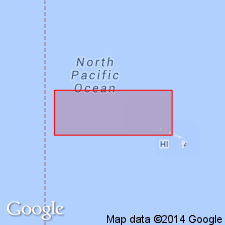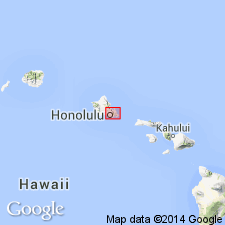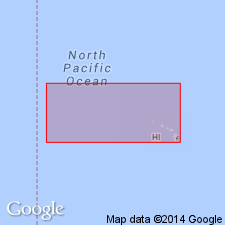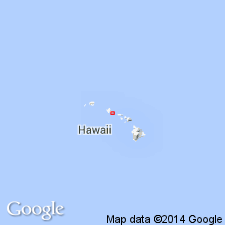
- Usage in publication:
-
- Kaau volcanics
- Modifications:
-
- Named
- Dominant lithology:
-
- Volcanics
- AAPG geologic province:
-
- Oahu
Summary:
Named after Kaau Crater [Honolulu and Koko Head quads] Island of Oahu. Extends into Palolo, Pukele, and Waiomao valleys. Included as unit in lower part of Honolulu volcanic series. Consists of lava flows, mud-flows and tuff deposits believed to have erupted from Kaau Crater. Geologic section at 550 ft elevation on east bank of Pukele stream is 85 ft thick. Unconformably overlies Koolau volcanic series and older alluvium. "The Kaau tuff and basalt flows were erupted during a high stand of the sea preceding the Waipio stand, but no data at hand to indicate which one." Assigned middle(?) and late Pleistocene age.
Source: GNU records (USGS DDS-6; Menlo GNULEX).

- Usage in publication:
-
- Kaau volcanics*
- Modifications:
-
- Age modified
- AAPG geologic province:
-
- Oahu
Summary:
... "the latest flows [of Kaau volcanics] may have been as recent as Kaena or Laie time."
Source: GNU records (USGS DDS-6; Menlo GNULEX).

- Usage in publication:
-
- Kaau volcanics*
- Modifications:
-
- Age modified
- AAPG geologic province:
-
- Oahu
Summary:
Composed of tuff and melilite-nepheline basalt erupted from Kaau Crater. Tuff formed in part by phreatic explosions. Secondary deposits of water-laid tuff occur below crater along Pukele, Waiomo [Waiomao], and Palolo Valleys. At least 2 lava flows are separated by tuff. Upper flow averages 20 ft in thickness. Covers fraction of sq mi in upper part of Palolo Valley and its tributaries on S side of Koolau Range. Lava overlies in part Koolau volcanic series and in part older alluvium. No fossils. Erupted probably during plus 95-foot (Kaena) stand of sea. Assigned Pleistocene age.
Source: GNU records (USGS DDS-6; Menlo GNULEX).

- Usage in publication:
-
- Kaau Volcanics*
- Modifications:
-
- Geochronologic dating
- AAPG geologic province:
-
- Oahu
Summary:
K-Ar ages on nepheline-melilite from Kaau vent ranges from 677 +/-23 to 617 +/-ka.
Source: GNU records (USGS DDS-6; Menlo GNULEX).

- Usage in publication:
-
- Kaau Volcanics†
- Modifications:
-
- Abandoned
- AAPG geologic province:
-
- Oahu
Summary:
Kaau Volcanics (Stearns, IN Stearns and Vaksvik, 1935) abandoned as formally named unit and called Kaau flows (and associated tuff and mudlflow deposits), informal unit of Honolulu Volcanics.
Source: GNU records (USGS DDS-6; Menlo GNULEX).
For more information, please contact Nancy Stamm, Geologic Names Committee Secretary.
Asterisk (*) indicates published by U.S. Geological Survey authors.
"No current usage" (†) implies that a name has been abandoned or has fallen into disuse. Former usage and, if known, replacement name given in parentheses ( ).
Slash (/) indicates name conflicts with nomenclatural guidelines (CSN, 1933; ACSN, 1961, 1970; NACSN, 1983, 2005, 2021). May be explained within brackets ([ ]).

